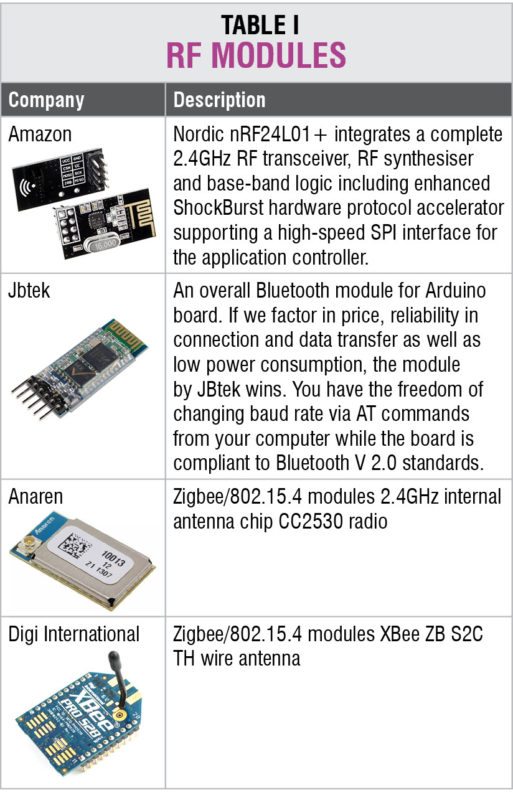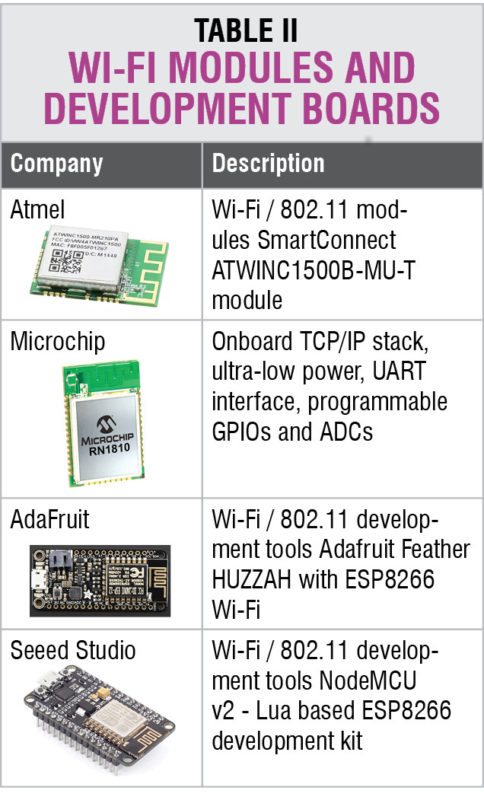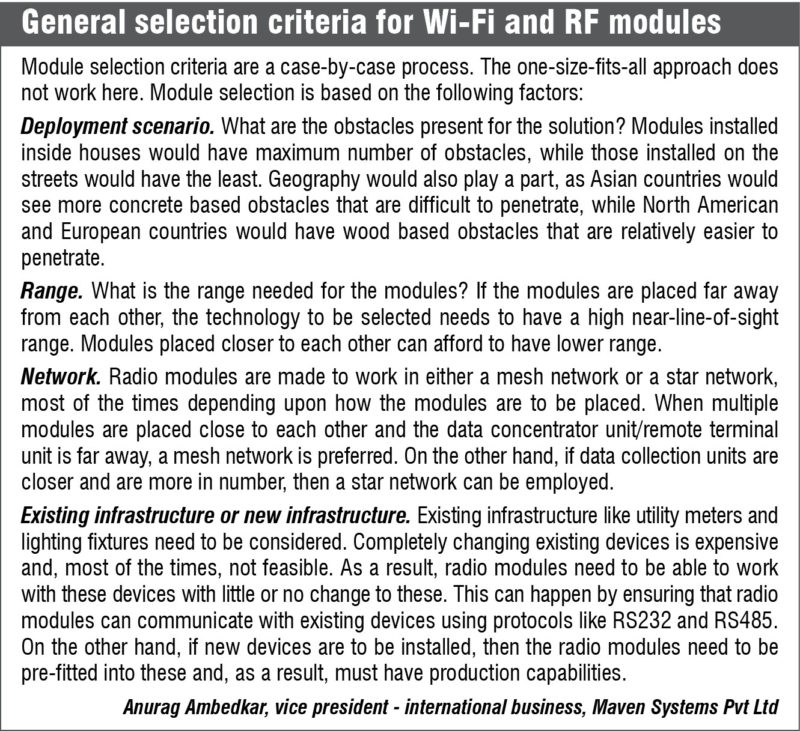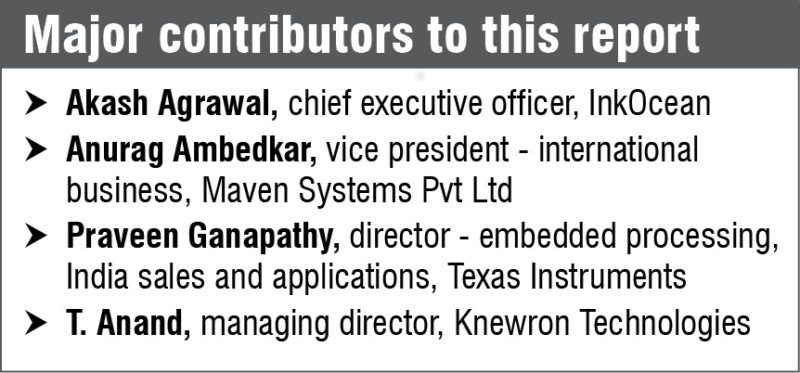When it comes to throwing data over the air, there are many options. If you are confused about which wireless technology is best for your next project, then keep on reading.
Most standard, well-known types include transmitter modules, receiver modules, transceiver modules and system on a chip (SoC) modules. An SoC module is the same as a transceiver module, but it is often made with an onboard micro controller (MCU). The MCU is typically used to handle radio data packetisation or managing a protocol such as an IEEE 802.15.4-compliant module. This type of module is typically used for designs that require additional processing for compliance with a protocol when the designer does not wish to incorporate this processing into the host MCU.
Performance of a radio frequency (RF) module depends on a number of aspects. With increasing transmitter power, a larger communication distance can be achieved. However, this also results in a higher electrical power drain on the transmitter device, which causes shorter operating life for battery-powered devices.
Also, a higher transmitting power can make the program prone to interference from all other RF devices. Increasing the sensitivity of the receiver also increases the effective communication range, but it also potentially causes malfunction due to interference from other RF devices.
RF modules selection
 General RF. RF link devices are the most barebone radio communication devices with the cheapest solution. Both the receivers and transmitters are needed to make a complete one-way link. RF link of 434MHz is more common.
General RF. RF link devices are the most barebone radio communication devices with the cheapest solution. Both the receivers and transmitters are needed to make a complete one-way link. RF link of 434MHz is more common.
RF module devices are inexpensive as well as smarter, as these are sold as single-unit transceivers capable of both sending and receiving data. RFM22 is a low-cost ISM FSK transceiver module that offers communication at 433MHz ISM and adjustable output power of up to +20dBm.
Pololu Wixel is a general-purpose programmable module featuring 2.4GHz radio and USB. You can write your own software or load precompiled, open source apps onto TI CC2511F32 MCU at the heart of Wixel, turning it into a wireless serial link, data logger or whatever you need for your current project.
Bluetooth. Bluetooth wireless protocol has two versions: Bluetooth Low Energy, which is marketed as Bluetooth Smart, and classic Bluetooth, which is the original standard version of Bluetooth. Compared to classic Bluetooth, Bluetooth Smart is designed to address the needs of new wireless applications such as ultra-low power consumption, fast connection times, reliability and security.
Texas Instruments CC2540 and its improved version, CC2541, have been very popular for several years. Both devices feature an 8051 processor, which enables your application to be tied to 8051 processor.
Nordic Semiconductor nRF8001 is a standalone device that requires an external MCU with SPI interface. The benefit of using such a device is that you can use your favourite MCU, as long as it meets all your application requirements, and the toolset that you already have.
Wi-Fi. Wi-Fi is one of the most common technologies for wireless connectivity, providing secure, reliable and fast Internet connectivity with IP protocol. Wi-Fi is awesome because it is available all over the place.
For high-capacity and high-quality mobile real-time applications that require video and voice capability, 802.11n provides operational advantages, with higher data throughput, greater range and robust link quality.
802.11ac offers twice the bandwidth of 802.11n. Use of multiple antennae (MIMO technology) further increases data rate and range.
nRF24L01 wireless transceivers with a 2.4GHz antenna provide easy implementation. The modules claim to support a communication range of 80 metres. With this range, you can play with your robot around the house or use it indoors to explore all rooms.
Diymall Esp8266 serial Wi-Fi wireless transceiver module Esp-01 takes care of Wi-Fi and TCP/IP stack. It supports SPI and UART connections. Both connections are ideal for pushing data up to the Internet for the Internet of Things (IoT) applications.
ESP8266 Esp-12e claims to offer a complete solution for Wi-Fi networking. It features storage capabilities and can choose intelligently and dynamically the best network available.
ZigBee. Zigbee/Xbee modules are advanced RF transceivers operating in the licence-free 2.4GHz frequency band. Zigbee transceivers are used where robust RF communication with high noise immunity and guaranteed packet delivery is required. The most common application of Zigbee modules is in sensor networks.
Digi ZigBee modules are long-range high-speed serial wireless communication modules that can give a range of 30 metres indoors or 100 metres outdoors. This module is ideal for robot-to-robot or robot-to-PC communications.
Microchip’s MRF24J40MA ZigBee module comes with an SPI interface with 120 metres range.
TARANG ZigBee modules manufactured by Melange systems can be interfaced using UART interface and can provide RF range of 100 metres to 50 kilometres with a directional antenna.
Thread. Thread is a new open global wireless standard developed to balance and improve on the increasingly important requirements of reliability, security, power efficiency and cost effectiveness. It runs on IEEE 802.15.4 physical radio specification and operates in the unlicensed ISM bands including 2.4GHz (v1.0).
Silicon Labs EM358x and EM359x families are optimised for both ZigBee and Thread networking stacks.
Proprietary. For applications that require longer range or support for proprietary protocols such as home automation, security and smart metering, sub-GHz and 2.4GHz proprietary wireless implementations offer substantive benefits over standards based, feature-rich protocols such as Wi-Fi, Bluetooth and ZigBee.
Flex Gecko is a family of 2.4GHz wireless SoCs targeted at proprietary wireless market.
Anurag Ambedkar, vice president – international business, Maven Systems Pvt Ltd, says, “The most important aspect of buying a wireless communication module has to be the end solution. It is necessary to consider various factors like range, cost and deployment geography. While protocols like ZigBee are successful in North America and Europe, the same does not stand true for Asia. As a result, the preferred modules should be by a company that is experienced in the local market and one that can customise to suit local needs.”
 He adds, “Maven has developed a wide variety of Wi-Fi modules using chipsets of Atheros, Broadcom, Roving Networks, AzureWave and Microchip. These modules communicate on either 2.4GHz or 5GHz frequency, along with AES, TKIP or WEP encryption for security. Maven has also developed a Wi-Fi-to-USB dongle that is being used by the US defence services.”
He adds, “Maven has developed a wide variety of Wi-Fi modules using chipsets of Atheros, Broadcom, Roving Networks, AzureWave and Microchip. These modules communicate on either 2.4GHz or 5GHz frequency, along with AES, TKIP or WEP encryption for security. Maven has also developed a Wi-Fi-to-USB dongle that is being used by the US defence services.”
Ambedkar further adds, “For RF modules, Maven’s WiART series is used in a wide variety of domains like smart metering, smart lighting and medical wearables. We support a wide variety of frequencies including 865MHz-868MHz, 915MHz and 2.4GHz. These modules are protocol-agnostic and work with minimum change to the exiting device protocol. Protocols supported by WiART include ZigBee protocol, BLE and Maven’s proprietary Sub1 GHz protocol (SmarttMesh).”
Akash Agrawal, chief executive officer, InkOcean, informs, “At Inkocean, I have sold a large variety of modules, some of which include Microchip’s IoT module RN2483, which is a low-powered Wi-Fi. Multiteh MTDOT-868-X1-SMA is another LoRa Wi-Fi. USR is a Chinese company with plenty of solutions and viral among its solution is USR-WIFI232-T. ESP8266 by Expressive has a large variety of modules from ESP01 to ESP14 that dominate the market. Some of the latest modules are ESP8066 12E, 14 and Wrooom and Esp32 Wi-Fi and Bluetooth, XBee Wi-Fi, node MCU and Adafruit cc3000.”
T.Anand, managing director, Knewron Technologies, says “For RF-driven modules, nRF24L01+ and RFM-96 are well-known modules. Both have closely-matching criteria.”
RajGuru Electronics offers XBee 2mW wire antenna – series 2, Xbee 1mW wire antenna – series 1, XBee Pro 63mW wire antenna – series 2B (ZigBee Mesh), XBee Explorer USB, XBee Explorer – Serial. Their Bluetooth modules (HC-05, HC05-TTL, ELM327, HM Bluetooth module and Bluetooth 4.0) offer an option of slave-and-master mode to the user and are available in a variety of specifications at reasonable prices.
Interface. RF modules typically communicate with an embedded system such as an MCU or microprocessor. Communication protocols include UART used in Digi International’s XBee modules, Serial_Peripheral_Interface_Bus used in Anaren’s AIR modules and USB used in Roving Networks’ modules. Although the modules may use a standardised protocol for wireless communication, commands sent over the MCU interface are typically not standardised, as each vendor has its own proprietary communications format.
Speed of the MCU interface depends on the speed of the underlying RF protocol used—higher speed RF protocols such as Wi-Fi require a high-speed serial interface such as USB, whereas protocols with a slower data rate such as Bluetooth Low Energy may use a UART interface.
IoT-driven modules. Embedded electronic devices are now adding the capability to be accessible from the Internet or be able to push data to the Cloud. This new trend in connecting smart electronic devices to the Internet is called the IoT. Many research studies have envisioned that 20 to 50 billion smart devices or things will be connected to the Internet by 2020. Attractiveness of the IoT market is driving the creation of many new businesses.

Main hardware components of an IoT device are:
Microcontroller unit. The processing unit together with the memory device
Connectivity module. Wireless or wired connectivity module enabling the device to communicate with other devices
Sensor module. Temperature, proximity, movement, humidity, current, voltage and so on
As in any design activity, there are several approaches to designing IoT hardware and devices like chip design solution, SoC design solution and embedded module solution. To avoid the risk of failure and project delays, many companies go with the module path. That does not mean that they are engaged in an easy path.
Wireless module selection is another challenge. Ambedkar says, “IoT-driven Wi-Fi modules connect a sensor or end node device directly to the Internet. These require a router in order to upload collected data to the Internet. Issues faced by such modules usually include limited penetration power, inefficient mesh network and lack of a standard protocol like ZigBee. On the other hand, these modules are relatively cheaper and can be accessed using mobile phones and tablet PCs, thus giving a better option for user touch points.
“IoT-driven RF modules connect to a gateway device and transmit data to it. The gateway then uses an appropriate connection backbone like GPRS, Wi-Fi, WiMAX or Ethernet in order to upload data to the Internet. Issues faced by these modules include an additional intermediary to upload data like a gateway and higher cost than Wi-Fi modules.
“However, both types of modules have a higher range and better penetration than Wi-Fi. Coupled with an efficient mesh protocol, RF modules find applications in all smartcity domains like smart metering and smart lighting.”
He adds, “In the Asian scenario in general and the Indian scenario in particular, solutions should use a combination of technologies. As mentioned earlier, concrete obstacles are aplenty and Internet connectivity is patchy in some areas. This calls for a solution that has an RF mesh to collect data from devices like utility meters, lighting fixtures and home sensors. This mesh would then transmit data to a gateway device. Using an appropriate connection backbone like Wi-Fi, Ethernet, WiMAX or GPRS, the gateway will then upload data to the Internet. The gateway device and RF modules need to be able to work even in the absence of Internet connectivity to ensure that the solution is not Internet-dependent.”
Praveen Ganapathy, director – embedded processing, India sales and applications, Texas Instruments India, adds, “We see broadest traction for BLE across segments, followed by Wi-Fi for home and enterprise segments, followed by sub-GHz radios with support for Zigbee, 6LowPAN and more in the industrial space. Near Field Communication is also seeing increased traction in payments, pairing and related applications involving authentication.”
Anand informs, “All Wi-Fi and RF modules are IoT-centered these days. However, not all fit due to the fact that some criteria do not match. For example, both NodeMCU and smartWi-Fi module are based on the same chipset, however, smartWi-Fi has a battery charger and a user button, LED on board, while NodeMCU does not, that makes the final setup much bulkier.”
Advantages of using Wi-Fi modules in IoT
There are many wireless interface options like Bluetooth Low Energy, ZigBee, Z-Wave, Wi-Fi and RFID, each with its own unique balance of power, range, data rates, mesh networking, interference immunity and ease of use. However, some interfaces are not yet native IP enabled, so cannot be addressed directly or exchange data with other devices and servers over the Internet. These require a separate gateway, adding expense and complexity to the final solution.
Wi-Fi is based on IEEE 802.11 standard with native IP addressability, is ubiquitous, well understood and can scale well in terms of data rates to optimise for power consumption. 802.11 standards are also IPv6 compliant, so there is almost no limit to the number of unique addresses.
Microchip supplies an IoT development kit (DM990001) using a module driven by a 32-bit controller. It employs two Microchip components, MRF24WG0MA/B pre-certified Wi-Fi module, which support both 802.11b and 802.11g, and PIC32MX695F512H MCU.
The starter kit powered by Amazon Web Services (AWS) is a managed Cloud platform that lets connected devices securely interact with Cloud applications. With AWS, IoT applications can keep track of and communicate with all networked devices, all the time, even when these are not connected.
Texas Instruments CC3100MOD, an FCC, IC, CE and Wi-Fi certified module, is a part of the new SimpleLink Wi-Fi family that dramatically simplifies implementation of Internet connectivity. It integrates all protocols for Wi-Fi and the Internet, which greatly minimises host MCU software requirements.
STMicroelectronics Intelligent Wi-Fi modules represent plug-and-play, standalone 802.11 b/g/n solutions for easy integration of wireless Internet connectivity features into existing or new products.

The future
Like most popular wireless technologies, Wi-Fi is constantly in a state of development. The latest iteration being rolled out is called 802.11ac, which provides rates up to 1.3Gbps in the 5GHz unlicensed band. Most access points, home routers and smartphones do not have it yet, but it is working its way into all of these.
Also underway is the process of finding applications other than video and docking stations for the ultrafast 60GHz (57GHz-64GHz) 802.11ad standard. It is a proven and cost-effective technology, but do we need 3Gbps to 7Gbps rates up to ten metres?
Wireless is certainly the future for the IoT and machine-to-machine communication. Wi-Fi is an obvious choice because it is ubiquitous, but it is overkill for some apps and a bit too power-hungry for others.
Bluetooth is another good option, especially Bluetooth Low Energy. Bluetooth’s new mesh and gateway additions make it even more attractive.
ZigBee is a ready-and-waiting alternative; so is Z-Wave. Then there are multiple 802.15.4 variants like 6LoWPAN.
As Wi-Fi chips get smaller with more features and solve the connection process problem, we can expect to see more IoT devices in the wild, monitoring the air, our health and more, as well as controlling physical objects from the Internet.
Biswajit Das is manager-R&D, EFY Labs








